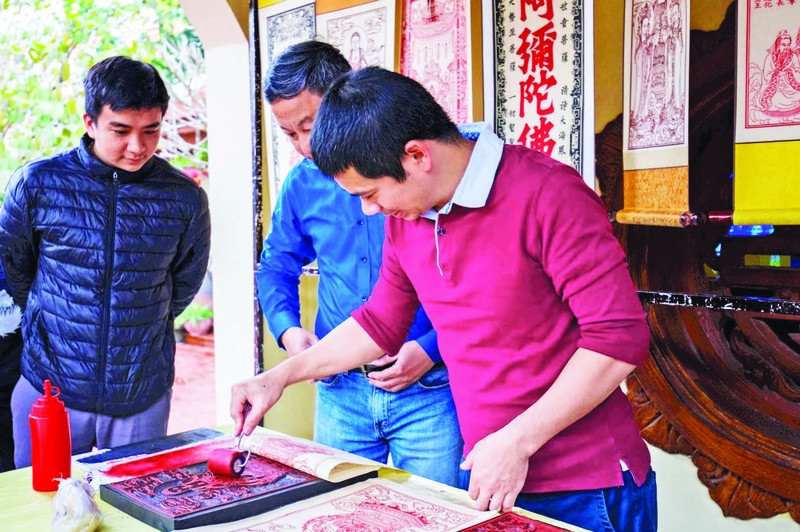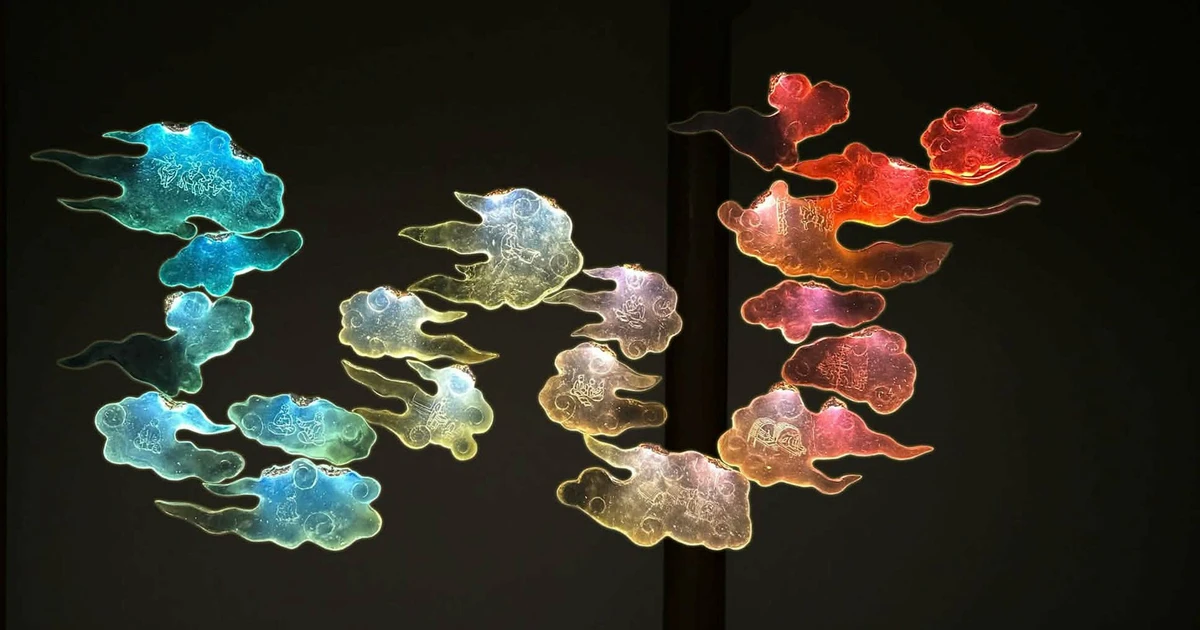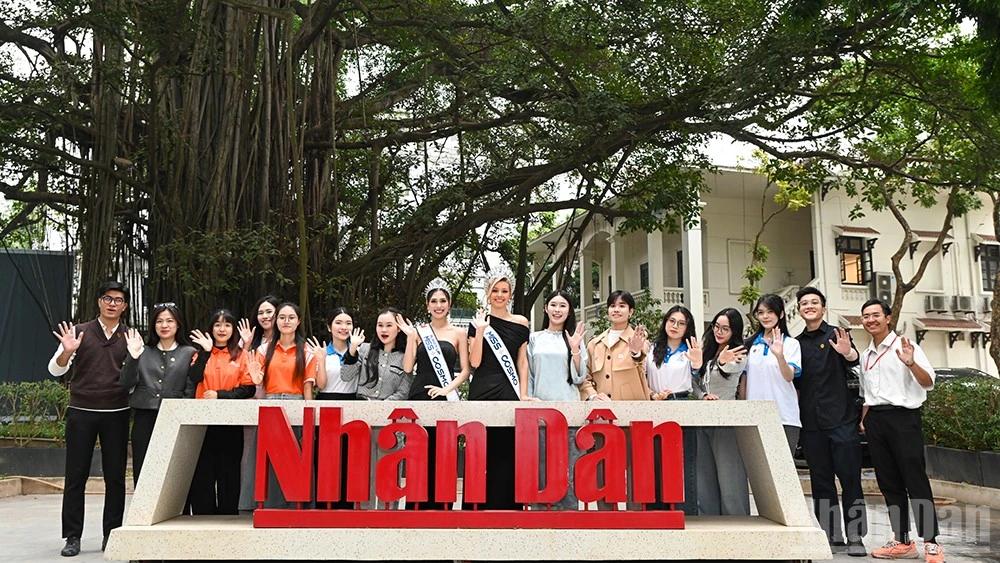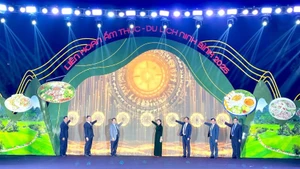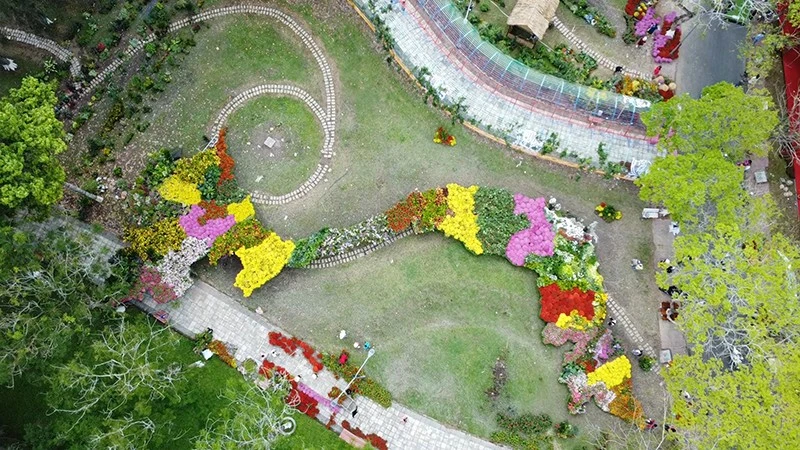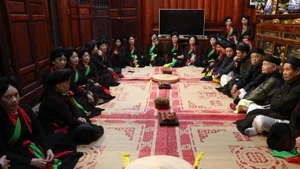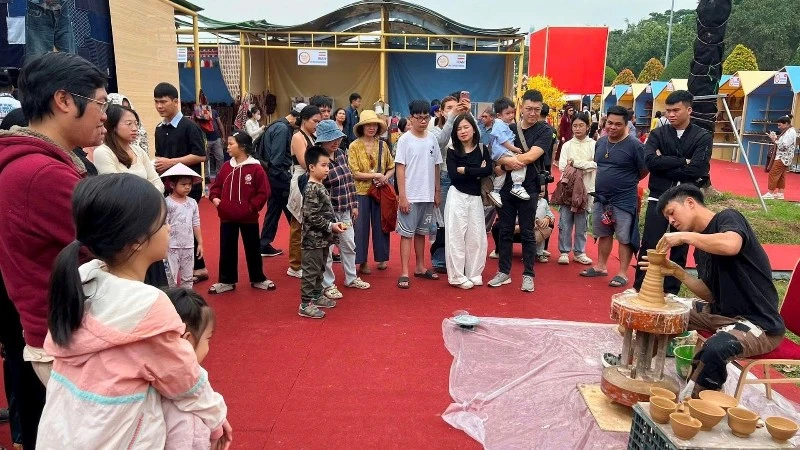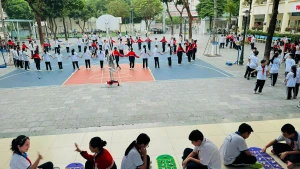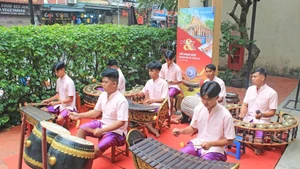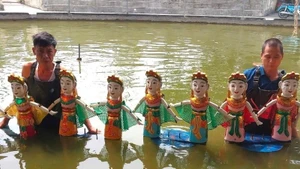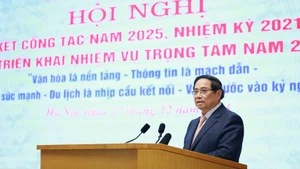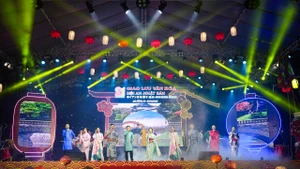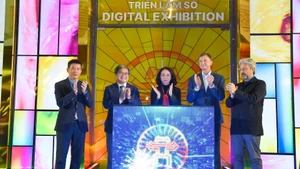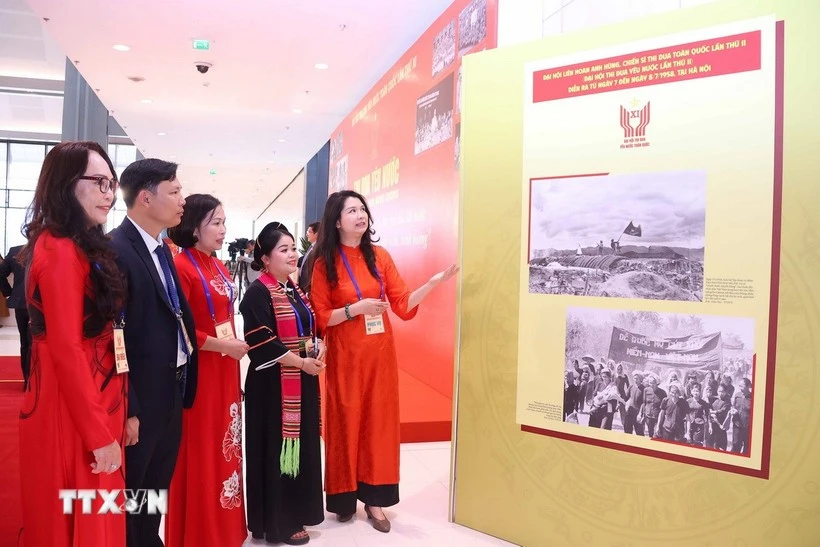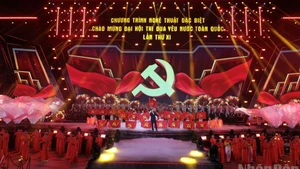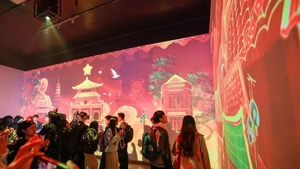Beginning with passion, these young people are not only awakening and spreading documentary heritage that has been dormant but also creating a new model for research and preservation of cultural values.
As the 2025 Vesak Day was preparing to open in Ho Chi Minh City, members of the Buddhist Heritage Conservation Office of Sung Phuc Temple, also known as Sui Temple, were busy participating in the Buddhist Cultural Exhibition.
In search of special heritage documents
The Office brought to the Buddhist Cultural Exhibition artefacts such as several ancient nine-dragon thrones, kasaya robes of notable monks, ancient Buddhist stupas, and more. Most prominently featured were Buddhist documentary heritage items including ancient and restored sutras, Buddhist woodblocks and rubbings of Buddhist steles. Among these were ancient sutras that the Office members had worked painstakingly to restore.
Nguyen Tien Hung, a member of the Office, said: “We have brought ancient sutras about the five periods of Dharma teaching in Buddha’s life. These documents were collected from many Buddhist sites such as Vinh Nghiem Temple in Bac Giang, Quan Su and Ba Da Temples in Hanoi. When we received them, the Buddhist sutras were all severely damaged, with some nearly in tatters. We spent considerable time restoring each page to bring them to the best possible condition, through which people can better understand the history of Buddhism in Viet Nam.”
The ten members of the Buddhist Heritage Conservation Office at Sui Temple are predominantly young. All have longstanding connections with cultural heritage in general and Buddhist culture in particular. Going back in time, more than ten years ago, Tran Ngoc Thoan was a student at Hanoi University of Science and Technology studying information technology, specialising in systems. While still at university, Thoan established a technology company.
By chance, he received requests to digitise sutras and books from several Buddhist temples, and each time he visited these temples, he clearly sensed a cultural flow of his homeland in each dark brown roof tile, in each statue or page of text... though at that time, he did not yet understand what content they contained. These feelings grew stronger and became an attachment as Thoan and his friends delved deeper to discover what these ancient books were saying. This became a turning point in his life. From a technology expert, Thoan became someone working in culture.
“We all know there is an enormous treasury of Sino-Nom documentary heritage left by our ancestors. But there are certain heritage groups in Buddhist temples that few people know about. People often speak of sutras or books about different Buddhist sects and lineages, but through our work, we found another very important group of documents: patriarch worship rituals. These are documents compiled when venerable monks had passed away or were about to pass away, describing their merits and life stories. These patriarch worship documents provide many missing pieces about Buddhist sects, lineages and the lives of monks. Each new discovery brings us joy and motivation to continue our work,” shared Tran Ngoc Thoan, Deputy Director of the Buddhist Heritage Conservation Office of Sui Temple.
One of the most interesting discoveries by Thoan and his colleagues was about the Xien Phap lineage (a major Buddhist lineage in the north) and the life and work of Master Tinh Dinh (1842-1901). Although only a recipient of Bodhisattva precepts, Master Tinh Dinh made great contributions in translating many sutras into Nom poetry, thereby helping spread Buddhist principles to the masses, most of whom were illiterate in previous centuries.
The deeper Thoan and his colleagues delved, the more they realised how much of the enormous Buddhist documentary heritage remained hidden beneath temple roofs. Some documents had not been revealed due to lack of interest. However, many documents belonged to a category that monks typically kept private within their own lineages, only bringing them out when needed. These documents were scattered across thousands of Buddhist temples, with many researchers not knowing where to find them.
With sincerity and respect for the country’s ancient values, and as if through a karmic connection with Buddhism, many temple abbots opened their hearts to Thoan and his colleagues, allowing them to access, digitise, systematise and share these documents with the community. To sustain his passion financially, Thoan founded Vilapa, a company specialising in religious publications, temple decoration, and digitisation services for heritage sites upon request.
Venerable Thich Thanh Phuong, the abbot of Sui Temple, is someone who loves traditional culture. After working with Thoan for many years and understanding the young people’s devotion to heritage, in 2022, Venerable Thich Thanh Phuong established the Buddhist Heritage Conservation Office of Sui Tempele, taking the role of director. The Office’s members are Thoan and other culture enthusiasts. Master Phuong allocated a space within the temple for them to conduct research on Buddhist culture and traditional culture. Thoan both manages his company to generate income to support research work and helps run the Buddhist Heritage Conservation Office of Sung Phuc Temple.
Journey to spread traditional values
The Buddhist Heritage Conservation Office of Sui Temple has inherited the documents that Thoan and his research group have developed over many years and now possesses an enormous archive of nearly 8,000 digitised Sino-Nom documents, including: sutras, books, inscriptions, steles, worship rituals, royal decrees, and many other documents. These materials have been collected, categorised and systematised for convenient research.
Subsequently, this entire vast archive was uploaded to the cloud. The Office provides access codes to any researcher, whether professional or amateur. Due to limited funding, the Office can only assign one specialist to each field. For example, Nguyen Tien Hung is responsible for document restoration, Le Thi Loi handles historical issues, and the Office also has experts in Sino-Nom script and technology. Throughout this process, many old, deteriorated paper documents have been restored by the team in cooperation with temples and owners, reviving many ancient texts.
Until now, research on traditional culture has primarily been conducted by research institutes, universities and colleges. The Buddhist Heritage Conservation Office of Sui Temple represents a new model for researching, preserving and promoting traditional cultural values by assembling a group of experts and operating on a combined research and business basis.
Under the guidance of Venerable Thich Thanh Phuong, the Buddhist Heritage Conservation Office has implemented the “Sacred Places” project, compiling data including photographs, videos, texts, 360-degree images and videos, and 3D drawings of temples, festivals and Buddhist knowledge. The Office aims to provide knowledge about Buddhist culture to everyone, making each tourism trip, pilgrimage, or Buddhist ceremony more meaningful.
Currently, the Sacred Places project has updated systematically organised information and images of more than 2,000 Buddhist temples. Anyone accessing the website www.chonthieng.com would be surprised to learn that this enormous amount of work on cultural and Buddhist heritage is provided by a small group of researchers and experts on an entirely non-profit basis.
To further share and spread these documents, and to collaborate with scholars to promote research, in February 2025, the Buddhist Heritage Conservation Office of Sung Phuc Temple established the East Asian Heritage and Culture Club.
Venerable Thich Thanh Phuong said: “In recent times, the Buddhist Heritage Conservation Office of Sui Temple has provided many valuable documents for research by organisations and individuals. The East Asian Heritage and Culture Club was established based on the research achievements of the Office, while emphasising the connection and preservation of cultural heritage, bringing culture closer to the public, creating conditions for people to access heritage, and providing new ways to preserve heritage through its activities.”
The Club has gathered dozens of professional and amateur researchers in various fields: history, Buddhist studies, fine arts, Sino-Nom studies, and more. Each month, the Club organises one meeting on different themes. For example, last March, topics discussed included: introduction to documents about Queen Mother Y Lan, discussion of the manuscript “Exploring Bac Ninh Steles” by researcher Nguyen Quang Khai, introduction to the book “Kinh Trieu Bao Luc - History of Dragon Lord and Lac Thi Water Deities”.
Although they have accomplished a substantial amount of work, Thoan and his colleagues believe there is still a long road ahead. “For instance, with our system of 8,000 Sino-Nom documents, going forward, we will upload them to a digital library for easier public access. We also wish to install NFC chip signs at heritage sites to further develop the Sacred Places project, or publish books based on the data we’ve discovered. The workload is enormous, requiring significant funding while our resources are limited. Therefore, we really hope for community cooperation to continue spreading the documentary heritage we possess,” Thoan shared.
